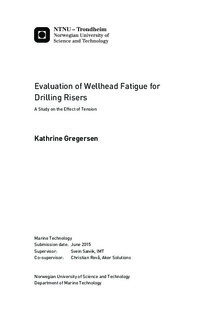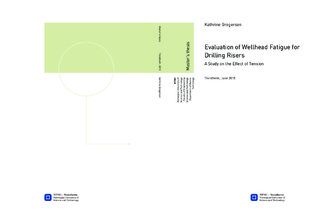| dc.description.abstract | In the oil and gas industry today, there is a renewed focus on structural integrity of the well- head. There exists no codes or standards on how to calculate wellhead fatigue today. However, a Joint Industry Project (JIP) was initiated to establish a Wellhead Fatigue Analysis Method (DNV; 2011). Several uncertainties related to the modelling and simulation of global load analyses were addressed in this report. In this thesis, the uncertainty related to how tension/overpull affects fatigue damage is investigated. Overpull is defined as the tension below the Lower Marine Riser Package (LMRP). In the Joint Industry Project it was assumed that the highest overpull will result in the highest fatigue damage (DNV; 2011).
A presentation of ongoing and previous work on wellhead fatigue is given. In addition, a description of the drilling riser system and relevant theory is presented. This includes theory related to the dynamic analysis of risers, fatigue damage, and a short overview of the wellhead fatigue analysis method.
A case study is conducted by applying different water depths, wellhead stiffnesses and overpulls in the range of 25-100 t. The global load analyses are carried out in SIMA/RIFLEX, which is a finite element software for slender marine structures. Irregular waves are applied using a JONSWAP spectrum with Hs=3.5 m and Tp=4.5-20.5 sec. In addition a uniform current, u=0.05 m/s, is applied. Both waves and current are applied in the same direction. The simulation length used is 1 hour. The relative fatigue damage is assessed applying SN-curves and Miner-Palmgren summation. In addition, bending moment histograms are produced for each case. The term relative damage is used since the fatigue calculation applies moments instead of stress in the calculations. It is assumed that the stress is linearly dependent on the bending moment, thus will the fatigue damage calculated be proportional to the actual fatigue damage.
The results from the global load analysis show that the lowest overpull (25 t) has the highest number of cycles for the high bending moment range. Hence, high fatigue damage is expected for this overpull. A low overpull leads to a very flexible system, resulting in large motion on the wellhead (load controlled behaviour). The largest overpulls (90 - 100 t) is seen to have a peak in its number of cycles for the second largest bending moment range. For high overpull the system is stiff, resulting in high axial forces on the wellhead (displacement controlled behaviour). Investigating a middle overpull of 80 t shows that it has a peak number of cycles for a lower bending moment range, thus resulting in a damage minima. When comparing the different water depths it is observed that the bending moment reduces for increasing depths, thus the fatigue damage is reduced for increasing water depth. It is found that reducing the wellhead stiffness increases the bending moment range where the peak in the number of cycles occurs, thus resulting in higher damage.
The fatigue calculation concludes that fatigue damage varies with overpull, and that it was not necessarily the largest overpull that led to the highest fatigue damage. The change in fatigue damage for the overpull with the lowest damage to the one with the highest damage was found to be 190-600 %, depending on the water depth. Moreover, it was found that a reduction in wellhead stiffness led to an increase in fatigue damage. The maximum increase in damage between the base case and 50 % reduction in wellhead stiffness was 75-140 % depending on the water depth. Increasing the water depth resulted in less fatigue damage. | |

